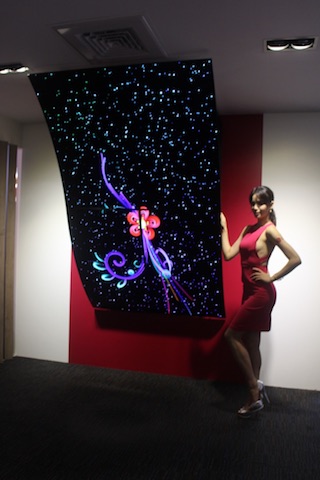(Author: Judy Lin, Chief Editor, LEDinside)
Debuting its OLED signage product portfolio for commercial applications on Tuesday, large Korean consumer electronic manufacturer LG is moving away from big-screened OLED TVs for home entertainment in Taiwan.
At a press conference held at the company’s office in Taipei, Taiwan, LG introduced its new range of OLED signage and displays for commercial application.
 |
|
On the left: Mark Park, Assistant Manager, Media PM Team, Taiwan, LG Electronics. Seen right: Bruce Kang, Manager, B2B Team, Taiwan, Taipei, LG Electronics. (All photos courtesy of LEDinside) |
Stepping away from consumer electronic mass production strategies seen in June 2016, where LG was eyeing high-income families that were willing to spend NT $80,000 (US $2542.59) on a TV set, the company will be offering its new range of OLED panels and displays on a project basis.
“We are not aiming to grab large market shares with these new OLED signages nor will pricing be our utmost priority,” said Bruce Kang, Manager, B2B Team, Taiwan, Taipei, LG Electronics. “Our premium OLED signages and displays will be offered for commercial applications.”
 |
 |
|
Top: Dual-view flat OLED display seen from the front. Bottom: Dual-view flat OLED display seen from the side. |
Differentiating from other major TV brands, LG is prioritizing customization for its new B2B OLED screen business model and project-based applications with its new OLED screens.
The company is in talks with several potential clients, and targeting luxury brands in the fashion industry such as Louis Vuitton and Coach, airports and Taiwan’s metro stations.
 |
 |
|
Top: Smart commercial solutions using LG OLED panels. Bottom: Transportation display applications using LG's 86BH5C OLED displays. |
“We will largely be focusing on customization and project-based applications,” said Bruce Kang, B2B Team Manager, Taiwan, Taipei, LG Electronics. “The displays can be customized so they can be integrated into architectural structures, the degree of curvature of the OLED display will depend largely on the architectural structure.”
A large LG OLED Open Frame curved display composed of several 55” OLED TVs connected together was shown at the press conference, the degree of the curve can be customized so the display itself becomes an architectural material. A similar display where more than 200 displays were seamlessly spliced together has been installed in Singapore.
 |
|
A showgirl shows off LG OLED Open Frame 55EF5C. |
One of the highlighted products at the press conference was a dual-view flat OLED display, which can be viewed from front and back. Different images can be displayed on the two paper thin displays, while installation methods include suspension, vertical display, and others. The display is suitable for art exhibitions, airports, and other open spaces.
Open Frame OLED displays and panels are flexible, have an extremely thin bezel, and deliver better Wide Color Gamut (WCG) performance than traditional LCDs. For commercial applications, LG offers a 3-year warranty for the OLED screens that have an average lifetime of 45,590 hours per year.
 |
|
LG OLED Open Frame 55EF5C seen from the side. |
“The OLED screens for our commercial application have a lifetime of 18 hours per day and a warranty of 3-years,” said Kang.
The company expects to ship the OLED displays by the third quarter of 2017 for a large installation project and did not reveal pricing for its new displays at the press conference.
 |
|
LG's UHD display 98LS95A. |
One of the reasons LG is switching its strategy is its commercial display products have done exceptionally well in Taiwan.
Since LG launched its commercial display product line in 2014 in Taiwan, LG has witnessed significant market growth, said Jason Kim, President of LG Taiwan office. “This year LG has seen significant growth in the commercial display market, our market share has surpassed 30%, and become the top commercial display brand in Taiwan,” he added.
In the Asia-Pacific region, Taiwan and Australia will be the first two markets where LG’s commercial OLED signages will be rolled out, said Mark Park, Assistant Manager, Media PM Team, Taiwan, LG Electronics.
The new market strategy will be rolled out globally, and the large OLED signage applications can already be seen in several public installations worldwide.
The company has had success in the past with its LED commercial signage business which it hopes to replicate, such as its successful installations of 3.5 mm bezel to bezel OLED displays at Singapore Changi Airport, and at Suntec Convention Center. The Singapore center boasts the Guinness World Record holder for largest HD video wall, spanning 4-story high and composed of 668 flat LED panels.
Based on LEDinside observations, focusing on the commercial application sector will be able to boost LG’s OLED display profits. Consumers lukewarm response to OLED TVs because of its higher price tags, compared to the more economic thin LCD panels has made it difficult for manufacturers to sell the next generation display. Manufacturers have been struggling to lower prices because large OLED panels low yield rates often raise manufacturing costs. By focusing on the commercial sector, LG has a chance of promoting OLED technology while minimizing absorbed manufacturing costs and potential losses.
Related articles for further reading:
//www.ledinside.com/news/2016/6/lg_electronic_to_launch_new_4k_oled_tv_in_taiwan



















